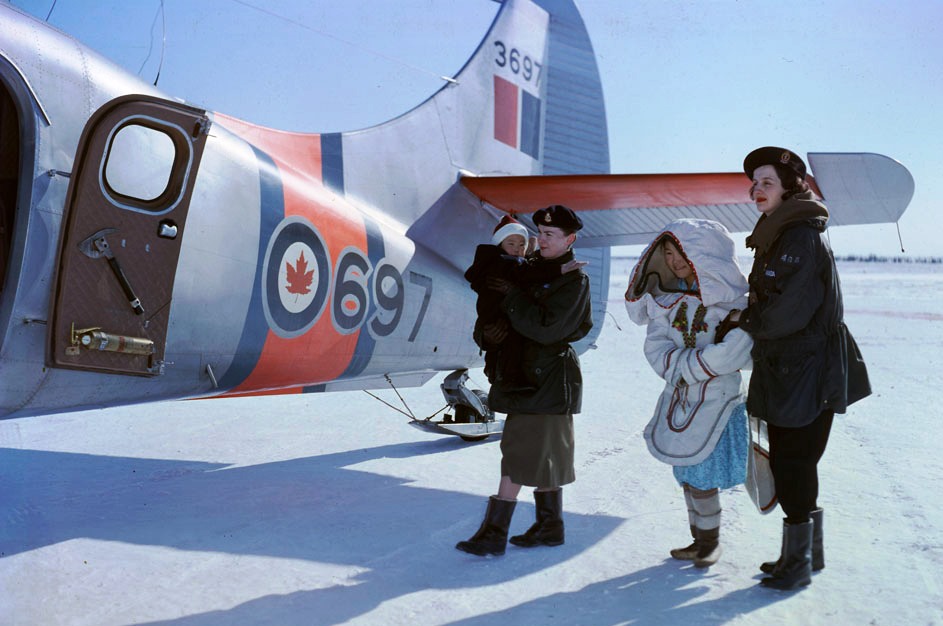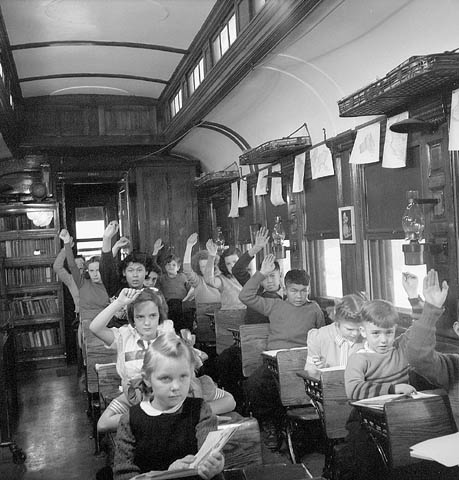
Nursing Sister at Fort Churchill, Manitoba, preparing to board an RCAF De Havilland Otter. Canadian-made bush planes such as the Otter and Beaver were the “covered wagons” of the Canadian North (Library and Archives Canada Photo, MIKAN No. 4234435)
This book was published in 1956, and it reflects a time when Canadians had very different things to think about. This was the period when a number of people became inspired by visions of the Northern Frontier. French-speaking Canadians seem to have been more caught up in it than English-speaking Canadians, who seem to have been more attracted to the magic of the blooming suburbs, but there were books like this published in both languages. The North was bristling with potential mineral wealth. The 1940s had already seen a Pioneer Movement, which was especially encouraged by influential people in Quebec, who wanted to divert the leakage of French Canadians migrating to New England (where they would certainly lose their language) into the Northern and Western Canada, where they would be able to keep it. This meant moving into the last remaining untouched patches of possible agricultural land in North America, and homesteading under the most extreme conditions. Some settlements failed, sometimes homesteads would be abandoned in moment of despair, the coffee pot left boiling on the stove. (It’s ironic that my mother, from an ancient Quebec family along the St. Lawrence, experienced both. Her family moved to Massachusetts to get work in the mills, but when she finished school, she returned to Canada and wound up in a subarctic Ontario mining town.)

1950, somewhere in Northern Ontario. A typical northern improvisation: the Schoolroom On Rails.
LeBourdais’ book is full of the optimism that swept Canadian economists, business, and politicians. Fabulous plans were made for roads and railways that would open up the North and assure Canada’s place as the Land of Opportunity. Many projects were actually started.
But within a decade, the Dream of the North was starting to fade. Quebec continued to pursue large scale hydro developments in the North, there continued to be a lot of activity in northern Alberta and Saskatchewan, and a lot of road-building in BC and the Yukon. But the Great Mackenzie Pipeline and the Highway to the Bering Sea (proposed in this book) never materialized. There was never any large population movement into the subarctic, and after Inuvik and Iqaluit, no more bright new space-station style towns founded in the high arctic. American and Russian submarines played tag in our arctic waters, and we all pretended it wasn’t happening. The last big project was the Dempster Highway, completed in 1979, a 736 km gravel road connecting Inuvik to the Klondike Highway in the Yukon. A friend and I hitched that road in the mid 1990’s, and it still had only one building on it’s entire length, the halfway truck-stop at Eagle Plains — one of the most beautiful places on Earth. The highway is named after the young Mounty constable who frequently ran the dog sled trail from Dawson City to Fort Mcpherson, which the highway roughly follows.
It’s interesting that the last few years have seen a renewal of public interest in the North, and a growing realization that, if Canada does have a future, it is going to have to revive some of that frontier sentiment. The recent kerfuffle over Hans Island shows that politicians are growing more sensitive about our shaky control of the farthest north. The diamond rush in the Northwest Territories has been bringing more and more adventurers to the arctic, and the new territory of Nunavut has been a reasonable success since it has assumed full self-government. Money is being poured into new snow roads, and upgrading the Dempster and Yellowknife roads.
Undoubtedly, any new Northern Frontier movement will have to be more ecologically sensitive and sophisticated than the brash plans of the 1950’s planners, but I wouldn’t be surprised if the next few years see the publication of new books that are not very different in spirit from this one that LeBourdais wrote in 1956. Perhaps I’ll end up writing one of them, myself.
0 Comments.